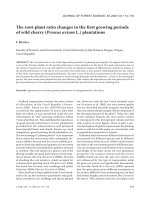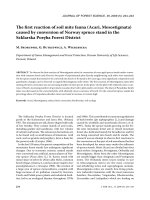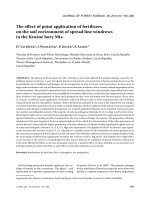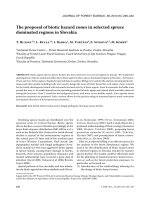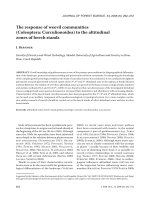Báo cáo lâm nghiệp: "The effect of excess nitrogen and of insect defoliation on the frost hardiness of bark tissue of adult oaks" pot
Bạn đang xem bản rút gọn của tài liệu. Xem và tải ngay bản đầy đủ của tài liệu tại đây (585.86 KB, 12 trang )
Short
note
The
effect
of
excess
nitrogen
and
of
insect
defoliation
on
the
frost
hardiness
of
bark
tissue
of
adult
oaks
FM
Thomas
R Blank
Niedersächsische
Forstliche
Versuchsanstalt,
Abt
B,
Grätzelstr
2,
37079
Göttingen,
Germany
(Received
9
December
1994;
accepted
31
October
1995)
Summary —
Deep
winter
frost,
causing
severe
bark
necroses,
and
insect
defoliation
are
two
of
the
causal
factors
for
the
present
oak
damages
in
northern
Germany.
In
earlier
investigations,
a
majority
of
oak
stands
had
shown
high
leaf
nitrogen
concentrations.
Therefore,
the
effect of
nitrogen
status
and
of
insect
defoliation
on
the
frost
hardiness
of
the
bark
of
adult
oaks
was
tested.
At
several
dates
dur-
ing
winter,
samples
from
the
living
inner
bark
tissue
were
taken
from
adult
sessile
(Quercus
petraea
[Matt]
Liebl)
and
pedunculate
oaks
(Q
robur L)
i)
with
normal
or
elevated
leaf
nitrogen
concentrations,
and
ii)
defoliated
or
nondefoliated
in
the
preceding
spring.
Frost
hardiness
of
bark
was
determined
by
elec-
trolyte
leakage
after
artificial
freezing
in
the
laboratory.
During
frost
periods
in
January
and
February,
oaks
with
lowered
C/N
ratios
in
bark
or
leaves
as
well
as
defoliated
trees
tended
to
reduced
frost
har-
diness.
Although
the
differences
were
insignificant
for
some
temperature
treatments,
it
is
concluded
that
the
effect
of
winter
frost
on
oak
damage
is
enhanced
by
a
supply
of
excess
nitrogen
and
by
preceding
insect
defoliation.
bark
/ frost
hardiness
/ insect
defoliation
/nitrogen
/ oak
decline
/ Quercus
Résumé —
Influence
d’un
excès
d’azote
et
de
la
défoliation
par
des
insectes
sur
la
résistance
au
gel
du
liber
de
chênes
adultes.
Les
grands
froids
de
l’hiver
qui
produisent
des
nécroses
sévères
du
liber,
ainsi
que
la
défoliation
causée
par
les
insectes,
sont
deux
causes
probables
du
dépérissement
actuel
des
chênes
en
Allemagne
du
Nord.
Dans
la
majorité
des
peuplements
de
chêne
explorés
on
a
détecté
une
forte
concentration
d’azote
dans
les
feuilles.
On
a
donc
recherché
l’influence
de
l’ali-
mentation
en
azote
et
de
la
défoliation
sur
la
résistance
au
gel
du
liber
de chênes
âgés.
En
hiver
on
a
prélevé
périodiquement
des
échantillons
du
liber
de
chênes
sessile
et
pédonculé
(Quercus
petraea
[Matt]
Liebl
et
Q
robur
L),
i) qui
présentaient
une
concentration
d’azote
normale
ou
élevée
dans
les
feuilles
ou
ii)
qui
présentaient
ou non
des
lésions
causées
par la
défoliation.
La
résistance
au
gel
a été
déter-
*
Present
address:
Universität
Göttingen,
Systematisch-Geobotanisches
Institut,
Untere
Karspüle
2,
37073
Göttingen,
Germany
minée
au
laboratoire
par
la
perte
d’électrolytes.
En
janvier
et
en
février
les
chênes
qui
avaient
un
faible
rapport
C/N
dans
les
feuilles
ou
dans
le
liber
ainsi
que
ceux
qui
présentaient
des
lésions
impor-
tantes
avaient
une
résistance
au
gel
réduite.
Quoique
les
différences
trouvées
n’aient
pas
toujours
été
significatives,
on
peut
conclure
que
la
sensibilité
aux
froids
d’hiver
est
renforcée
par
une
teneur
en
azote
excessive
et
par
une
défoliation
antérieure.
azote
/ défoliation
/ dépérissement
du
chêne
/ liber / Quercus
/ résistance
au
gel
INTRODUCTION
Deep
winter
frost
is,
besides
insect
defolia-
tion
and
drought,
supposed
to
be
one
of
the
causal
factors
for
the
several
events
of
decline
of
sessile
and
pedunculate
oak
(Quercus petraea
[Matt]
Liebl,
and
Q
robur
L)
in
northern
Germany
during
the
last
250
years.
The
present
outbreak
of
damages
started
in
1982-1983
and
culminated
in
1987-1989
after
three
winters
with
severe
frost.
Therefore,
winter
frost
is
supposed
to
be
the
synchronizing
factor
of
the
present
’oak
decline’
in
northern
Germany
(Hart-
mann
et
al,
1989;
Balder,
1992;
Hartmann
and
Blank,
1992,
1993).
Up
to
20%
of
the
declining
oaks
showed
primary
bark
necroses
at
the
stem,
preferably
on
the
southern
and
southwestern
sides
(Hartmann
et
al,
1989;
Hartmann
and
Blank,
1992).
It
is
well-known
that
a
supply
of
excess
nitro-
gen
can
lead
to
a
reduced
frost
hardiness
of
plant
tissue
(Larcher,
1985).
Defoliation
as
well
can
lower
the
frost
hardiness
in
the
fol-
lowing
winter
(Sakai
and
Larcher,
1987).
Since
insect
defoliation
is
one
of
the
pri-
mary
causal
factors
of
oak
decline
in
north-
ern
Germany,
and
since
the
majority
of
oak
stands
investigated
in
northwestern Ger-
many
had
shown
high
leaf
nitrogen
con-
tents
as
compared
to
literature
data
(Thomas
and
Büttner,
1992;
Thomas
and
Kiehne,
1995),
the
frost
hardiness
of
living
bark
tissue
from
adult
oaks
was
tested
in
two
sets
of
investigations:
i) in
trees
differing
in
leaf
nitrogen
concentrations,
and
ii)
in
nondefoliated
oaks
versus
trees
defoliated
in
the
preceding
spring.
Frost
hardiness
was
determined
by elec-
trolyte
leakage
after
artificial
freezing.
In
trees,
this
method
has
been
widely
used,
for
example,
in
stem
sections
of
seedlings
(Van
den
Driessche,
1969;
Green
and
War-
rington,
1978),
lateral
shoots
(Dueck
et
al,
1990/1991;
Sheppard
et
al,
1994),
and
pieces
of
twigs
(Alexander
et
al,
1984)
and
needles
(Aronsson,
1980;
Kolb et al,
1985;
Burr
et
al,
1990),
but
only
rarely
in
bark
tis-
sue
(Ashworth
et
al,
1983).
Since
in
dam-
aged
oaks
visible
frost
injury
was
found
in
the
living
bark,
samples
from
this
tissue
were
used
to
test
frost
hardiness.
The
frost
hardiness
determined
by
the
method
employed
depends
not
only
on
the
type
of
organ
or
tissue
and
the
time
of
sam-
pling,
but
also
on
the
freezing
treatment
itself
(rate
of
cooling,
duration
of
exposure,
etc).
Therefore,
it
does
not
reflect
the
actual
frost
hardiness
of
the
tissue
under
field
con-
ditions
and
cannot
be
correlated
directly
with
outside
temperatures.
As
a
relative
parameter,
however,
it
can
be
used
for
the
comparison
of
two
or
more
sets
of
samples
taken
at
the
same
time
from
trees
subjected
to
similar
climatic
conditions.
Since
both
the
magnitudes
and
the
courses
of
air
temperatures
measured
at
the
meteorological
stations
used
as
a
ref-
erence
for
the
stands
to
be
compared
were
very
similar,
the
climatic
conditions
of
those
stands
which
are
relevant
for
frost
effects
could
be
regarded
as
nearly
equal.
There-
fore,
the
factors
tested
are
thought
to
have
a
decisively
greater
influence
on
bark
frost
hardiness
than
stand
effects
which
may,
however,
have
contributed
to
a
certain
extent
to
the
differences
found
between
stands.
MATERIALS
AND
METHODS
The
investigation
was
carried
out
at
the
Nieder-
sächsische
Forstliche
Versuchsanstalt
(Lower
Saxony
Forest
Research
Station),
Göttingen,
Germany.
Investigation
sites
For
the
examination
of
the
nitrogen
effect,
two
stands
of
adult
sessile
oaks
in
eastern
Lower
Saxony
(Sprakensehl
and
Busschewald;
sam-
pling
from
December
1992
to
March
1993),
and
two
stands
of
adult
pedunculate
oaks
in
eastern
Schleswig-Holstein
and
eastern
Lower
Saxony
(Eutin
and
Lüchow;
sampling
in
February
1994)
were
chosen
(fig
1).
The
stands
differed
in
N
con-
centrations
and
C/N
ratios
of
leaves
and
bark
(table
I).
The
selected
trees
did
not
show
any
symptom
of
decline.
The
daily
minimum
air
tem-
peratures
were
obtained
from
meteorological
sta-
tions
of
the
German
Meteorological
Service
(Deutscher
Wetterdienst)
which
were
at
a
dis-
tance
of
up
to
50
km
from
the
stands
and
reflected
the
weather
situation
of
the
region.
During
both
winters,
the
courses
of
the
minimum
tempera-
tures
were
similar
in
the
regions
of
the
stands
to
be
compared
(figs
2,
3).
The
effect
of
earlier
defoliation
was
investi-
gated
during
January
and
February
1993
in
one
stand
of
ca
150-year-old
sessile
oaks
in
the
Hakel
Forest
(forest
district
Pansfelde,
western
Saxony-
Anhalt)
comparing
six
severely
defoliated
and
six
trees,
and,
in
January
and
Febru-
ary
1994,
in
one
stand
of
130-year-old
peduncu-
late
oaks
in
the
forest
district
Lappwald
(eastern
Lower
Saxony)
comparing
12
severely
defoliated
and
three
nondefoliated
trees
(fig
1).
Defoliation
had
been
caused
by
larvae
of
Tortrix
viridana
L
and/or
Operophthera
brumata
L
in
the
preced-
ing
spring
(after
bud-burst
in
May).
In
July,
how-
ever,
after
flushing
of
dormant
buds,
the
foliage
was
almost
completely
reestablished.
Apart
from
defoliation,
no
visible
symptoms
of
injury
occurred.
Sampling,
determination
of
frost
hardiness,
chemical
analyses
After
removal
of
the
outer
bark,
samples
with
a
diameter
of
10
mm
and
ca
5
mm
thick
were
taken
from
the
inner
living
bark
with
a
cork
borer
at
breast
height
from
the
southwestern
sides
of
the
trunks
where,
in
February,
frost
hardiness
had
been
shown
to
be
lower
than
at
the
opposite
side
(Thomas
and
Hartmann,
1992).
Sampling
was
carried
out
on
the
same
day
on
the
trees
to
be
compared.
The
bark
samples
were
transferred
in
a
cold
bag
to
the
laboratory
and
cooled
in
a
cryostat
with
a
cooling
rate
of
5
°C
h
-1
accord-
ing
to
Kolb
et
al
(1985).
The
samples
were
cooled
down
to
two
freezing
levels:
-10
or
-15 °C,
respectively,
and
-25
°C.
At
freezing
tempera-
tures
higher
than
-10 °C,
sometimes
only
a
very
small
response
is
obtained
from
samples
taken
during
winter
(Thomas
and
Hartmann,
1992).
Air
temperatures
around -25 °C
had
caused
primary
bark
necroses
in
the
severe
winters
of
1985-1987
(Hartmann
and
Blank,
1992).
Each
desired
freez-
ing
level
was
maintained
for
30
min
before
removal
of
the
samples.
The
control
samples
were
kept
in
a
refrigerator
at
ca
+5
°C.
Three
replicates
were
employed
for
control
and
each
freezing
treatment.
As
a
measure
of
the
freezing
damage,
the
electrolyte
leakage
of
the
tissue
was
determined
according
to
Ritchie
(1991).
After
thawing
in
a
refrigerator,
each
sample
was
infiltrated
with
5
mL
of
3%
propanole
in
highly
purified
water
and
incu-
bated
in
this
solution
for
24
h
at
25 °C
(yielding
about
90%
of
the
leachable
solute
as
had
been
tested
in
preliminary
studies).
After
incubation,
the
conductivity
of
the
solution
was
measured,
and
the
tissue
was
killed
by
autoclaving
at
120 °C
for
20
min.
After
that,
incubation
and
determina-
tion
of
the
conductivity
were
repeated.
From
the
ratios
of
the
conductivity
values
before
and
after
autoclaving
obtained
from
treatment
and
control
samples,
an
index
of
injury,
It,
was
calculated
for
each
freezing
treatment
according
to
Flint
et
al
(1967),
the
range
of
this
index
being
0%
(no
freez-
ing
damage)
to
100%
(tissue
completely
killed).
In
the
bark
samples,
the
nitrogen
concentrations
and C/N
ratios
were
determined
with
a
C/N
ana-
lyzer
(two
replicates
per
tree)
for
each
sampling
date.
Statistics
The
results
are
given
as
means
with
standard
errors.
For
statistical
analyses,
the
Mann-Whit-
ney
ranked
sum
test
(U-test)
was
employed.
Cor-
relation
coefficients
were
tested
against
the
dis-
tribution
of
t-values.
The
significance
level
was
5%
in
each
case.
RESULTS
Frost
hardiness
of
bark
tissue
from
oaks
differing
in
the
C/N
ratios
of
bark
or leaves
In
January
1993,
after
ca
2
weeks
of
per-
manent
frost
with
temperatures
down
to
about
-13 °C,
the
indices
It
were
higher
in
the
bark
tissue
from
the
sessile
oaks
in
Busschewald
as
compared
to
samples
from
Sprakensehl,
indicating
lower
frost
hardi-
ness.
For
the
-10 °C
treatment,
the
differ-
ence
was
significant
(fig
4a).
At
the
begin-
ning
of
February,
the
tendency
was
the
same,
but
the
differences
failed
to
be
sig-
nificant.
At
the
other
sampling
dates,
no
dis-
tinct
differences
could
be
detected.
In
the
oaks
of
Busschewald,
as
compared
to
the
trees
in
Sprakensehl,
the
nitrogen
concen-
trations
were
significantly
higher
and
the
C/N
ratios
significantly
lower
not
only
in
the
leaves
harvested
in
the
preceding
summer,
but
also
in
the
bark
tissue
sampled
in
Jan-
uary
(table
I).
From
bark
tissue
taken
in
February,
similar
values
were
obtained,
but
the
differences
were
statistically
insignifi-
cant.
For
the
tissue
sampled
in
January
and
February,
however,
a
significantly
negative
correlation
was
found
between
C/N
ratios
and
freezing
damage
at
-10
°C
(fig
5).
In
contrast,
only
a
weak
correlation
was
found
if
the
whole
set
of
samples
taken
between
December
and
March
was
considered
(r =
-0.35).
In
late
winter
1993-1994,
deep
frost
did
not
occur
until
mid-February
(fig
3).
The
bark
tissue
from
the
pedunculate
oak
stand
in
Eutin
which
had
lower
C/N
ratios
in
the
bark
(table
I)
and
tended
to
higher
nitrogen
concentrations
and
lower
C/N
ratios
of
the
leaves
showed,
at
the
-10
°C
treatment,
a
significantly
higher
index
of
injury
than
sam-
ples
from
the
stand
in
Lüchow
(fig
4b).
Frost
hardiness
of
bark
tissue
from
defoliated
and
nondefoliated
oaks
Compared
to
nondefoliated
trees,
defoliated
sessile
and
pedunculate
oaks
tended
to
increase
freezing
damage
of
the
bark
tis-
sue.
The
differences
were
significant
for
two
treatments
(fig
6).
In
one
case,
nondefoli-
ated
oaks
showed
a
significantly
lower
frost
hardiness
(fig
6b).
This
was,
however,
dur-
ing
a
period
with
relatively
mild
tempera-
tures
(cf
fig
3)
when,
possibly,
optimum
frost
hardiness
had
not
yet
developed.
DISCUSSION
During
winter,
the
It
values
obtained
in
this
investigation
were
rather
low.
In
samples
from
sessile
oaks,
the
maximum
mean
value
found
was
19.9
±
3.0%
(Busschewald,
1
February
1993),
and
in
samples
from
pedunculate
oak,
it
was
16.5
±
2.6%
(Lapp-
wald,
26
January
1994),
determined
after
freezing
at -25 °C.
Generally,
the
It
values
of
bark
from
sessile
oaks
were,
at
compa-
rable
sampling
dates,
higher
than
It
values
of
bark
from
pedunculate
oak.
This
finding
is
in
accordance
with
the
commonly
held
opin-
ion
that
sessile
oak
is
more
susceptible
to
winter
frost
than
pedunculate
oak
(cf
Ellen-
berg,
1986).
The
low
It
values
generally
found
in
Jan-
uary
and
February
point
to
a
relatively
high
extent
of
hardening.
Distinct
higher
It
was
not
detected
before
early
spring,
after
the
presumed
onset
of
dehardening.
Figure
7
gives
a
compilation
of
maximum
It
values
determined
with
the
above-stated
method
(but
by
freezing
between
-20
and
-30
°C)
at
different
dates
during
winter
for
the
sun-
exposed
(southwestern)
and
shaded
(north-
eastern)
side
of
the
trunk
of
sessile
oaks
in
Sprakensehl,
showing
the
course
of
hard-
ening
and
dehardening
of
the
tissue.
The
highest
It
value
found
in
this
series
of
tests
was
55%,
obtained
at
the
end
of
April.
In
both
oak
species,
bark
tissue
with
a
lower
C/N
ratio
sampled
during
cold
peri-
ods
showed,
mainly
after
the
-10
°C
treat-
ment,
tendencies
of
a
reduced
frost
hardi-
ness
(figs
2-4).
The
finding
of
increasing
freezing
damage
at
-10
°C
with
decreas-
ing
C/N
ratios
of
the
bark
tissue
sampled
from
sessile
oak
in
January
and
February
1993
(fig
5)
points
to
a
connection
between
excess
nitrogen
supply
and
frost
hardiness
of
the
bark.
For
the
sampling
dates
in
December
1992
and
March
1993,
it
can
be
assumed
that
frost
hardiness
of
the
tissue
was
not
at
its
maximum
(fig
7)
and
that,
therefore,
significant
differences
were
pre-
vented.
At
temperatures
lower than
-10
°C,
the
frost
effect
presumably
outweighed
the
nitrogen
effect. This could
be
the
reason
for
the
finding
of
only
insignificant
differences
at
these
freezing
levels.
The
finding
of
higher
N
concentrations
in
the
bark
tissue
of
pedunculate
oaks,
com-
pared
to
sessile
oaks,
is
in
accordance
with
the
fact
that
the
leaves
of
pedunculate
oak
also
often
show
higher
N
concentrations
(cf
Van
den
Burg
1985, 1990).
The
differences
in
leaf
nitrogen
concentrations
and
C/N
ratios
between
the
stands
to
be
compared
were
not
extreme.
However,
more
distinct
differences
between
meteorologically
com-
parable
stands
were
not
detected.
In
37 oak
and
mixed
oak
stands
investigated
in
Lower
Saxony
and
Schleswig-Holstein
from
1990
to
1992,
mean
leaf
nitrogen
concentrations
were
not
below
22
mg
g
-1
DM
and
mean
leaf
C/N
ratios
not
above
21.5
g
g
-1
in
healthy
trees.
In
23
stands,
however,
leaf
nitrogen
concentrations
exceeded
the
upper
threshold
of
the
’normal
range’
which
can
be
assumed,
according
to
Van
Den
Burg
(1985, 1990),
to
be
25
mg
N
g
-1
DM
in
ses-
sile
oak
and
27
mg
N
g
-1
DM
in
pedunculate
oak.
The
elevated
nitrogen
concentrations
were
accompanied
by
increased
ratios
of
N/P
and
N/Mg,
pointing
to
nutritional
dishar-
monies
(Thomas
and
Büttner,
1992;
Thomas
and
Kiehne,
1995).
The
differences
in
leaf
nitrogen
concentrations
and
C/N
ratios
between
the
stands
in
Eutin
and
Lüchow
found
in
July
1994
were
small.
Pre-
vious
investigations
in
the
same
forest
dis-
tricts,
however,
had
revealed
larger
dis-
crepancies
(24.6
mg
N
g
-1
DM
and
C/N
20.2
in
Lüchow,
and
30.6
mg
N
g
-1
DM
and
C/N
17.2
in
Eutin).
The
discussion
on
the
effect
of
excess
nitrogen
on
forest
dieback
in
Europe
has
been
stimulated
by
Nihlgård
(1985)
who
stated
that,
besides
other
adverse
effects,
"increased
amounts
of
leaf-nitrogen
cause
a
decrease
in
frost
hardiness".
Indeed,
it
had
been
shown
that
Scots
pine
and
Norway
spruce
trees
fertilized
with
nitrogen
showed
reduced
frost
hardiness
of
needles
and
higher
amounts
of
injured
needle
cells,
prob-
ably
due
to
winter
frost,
compared
to
control
trees
(Aronsson,
1980;
Soikkeli
and
Kären-
lampi,
1984).
Fumigation
of
Scots
pine
saplings
with
ammonia
did
reduce
the
frost
hardiness
of
the
needles
after
freezing
at
-10
°C
and
below
(Dueck
et
al,
1990/1991).
Our
data
give
evidence
to
a
decrease
in
frost
hardiness
of
the
bark
of
broad-leaved
deciduous
trees
with
elevated
leaf
nitrogen
concentrations.
However,
the
extent
of
the
contribution
of
excess
nitrogen
to
forest
damage,
and
to
oak
decline
in
particular,
remains
to
be
clarified
as
does
the
physio-
logical
mechanism
of
impairment.
Possibly,
the
increased
demand
of
carbon
skeletons
due
to
the
need
of
enhanced
nitrogen
assim-
ilation
after
excess
nitrogen
uptake
leads
to
a
reduction
in
the
contents
of
soluble
sug-
ars
and/or
carbohydrate
derivatives,
serv-
ing
as
cryoprotectants
(see
later).
In
both
oak
species,
insect
defoliation
in
spring
tended
to
increase
the
damage
caused
by
artificial
freezing
of
bark
tissue
sampled
during
frost
periods
of
the
following
winter.
However,
the
connection
between
spring
defoliation
and
decrease
in
frost
har-
diness
has
to
be
confirmed
by
further
tests.
A
decrease
in
frost
hardiness
can
be
due
to
lowered
carbohydrate
contents.
The
cold
resistance
of
roots,
rhizomes,
xylem
and
phloem
tissue
and
buds
from
several
trees
and
shrubs
was
found
to
correlate
with
the
concentration
of
carbohydrates,
especially
of
sugars
(Parker,
1962;
Kaurin
et
al,
1981;
Korotaev,
1994).
Leaf
loss
caused
by
spring
defoliation
of
the
oaks
investigated
could,
together
with
the
following
reestablishment
of
leaf
biomass
by
flushing
of
dormant
buds,
have
led
to
an
impaired
replenishment
of
the
carbohydrate
pool,
thereby
affecting
cold
hardiness
in
two
possible
ways:
i)
by
a
decrease
in
the
concentrations
of
soluble
sugars,
leading
to
increased
susceptibility
to
dehydration
caused
by
extracellular
freez-
ing;
and/or
ii)
by
a
decrease
in
the
concen-
trations
of
cryoprotectants
(eg,
sugar
alco-
hols),
resulting
in
increased
susceptibility
to
intracellular
freezing.
Since
it
has
been
shown
that
freezing
damage
to
bark
tissue
mainly
is
due
to
extracellular
ice
formation
(Ashworth
et
al,
1983;
Malone
and
Ash-
worth,
1991),
it
seems
that
the
role
of solu-
ble
sugars
is
more
important.
Further
inves-
tigations
are
necessary
for
a
better
understanding
of
the
underlying
physiolog-
ical
mechanisms.
The
findings
of
adverse
effects
of
ample
N
supply
and
of
spring
defoliation
on
frost
hardiness
of
the
bark
still
need
further
exper-
imental
confirmation;
however,
they
are
in
good
accordance
with
results
of
tree
ring
analyses
of
600
adult
oaks
in
northern
Ger-
many
having
shown
that
severe
growth
reductions
are
accompanied
by
the
com-
bined
occurrence
of
at
least
two
of
the
fac-
tors
insect
defoliation,
drought,
and
deep
winter
frost,
the
latter
being
regarded
as
the
synchronizing
factor
for
the
outbreak
of
the
present
oak
damages
in
northern
Germany
(Hartmann
and
Blank,
1992).
ACKNOWLEDGMENTS
This
research
was
supported
by
the
German
Bun-
desministerium
für
Forschung
und
Technologie
(BMFT),
Project
no
0339382A.
The
authors
are
responsible
for
the
content
of
the
publication.
We
would
like
to
thank
Pr
Dr
M
Popp
and
Dipl-biol
T
Große
Schulte,
University
of
Münster,
Institute
of
Applied
Botany,
for
the
analyses
of
C
and
N
of
bark
tissue
sampled
from
the
stands
in
Buss-
chewald
and
Sprakensehl.
REFERENCES
Alexander
NL,
Flint
HL,
Hammer
PA
(1984)
Variation
in
cold-hardiness
of
Fraxinus
americana
stem
tissue
according
to
geographic
origin.
Ecology (Durham)
65, 1087-1092
Aronsson
A
(1980)
Frost
hardiness
in
Scots
pine
(Pinus
silvestris
L).
lI.
Hardiness
during
winter
and
spring
in
young
trees
of
different
mineral
nutrient
status.
Stud
Forest Suecica
155,
1-27
Ashworth
EN,
Rowse
DJ,
Billmyer
LA
(1983)
The
freez-
ing
of
water
in
woody
tissues
of
apricot
and
peach
and
the
relationship
to
freezing
injury.
J Am Soc
Hort
Sci 108, 299-303
Balder
H
(1992)
Europaweite
Eichenschäden
durch
Frost.
Allg
Forst Z 47, 747-752
Burr
KE,
Tinus
RW,
Wallner
SJ,
King
RM
(1990)
Com-
parison
of
three
cold
hardiness
tests
for
conifer
seedlings.
Tree
Physiol6,
351-369
Deutscher
Wetterdienst
(1992-1994)
Monatlicher
Wit-
terungsbericht.
Deutscher
Wetterdienst,
Offenbach
Dueck
TA,
Dorel
FG,
Ter
Horst
R,
Van
der
Eerden
LJ
(1990/1991)
Effects
of
ammonia,
ammonium
sul-
phate
and
sulphur
dioxide
on
the
frost
sensitivity
of
Scots
pine
(Pinus
sylvestris
L).
Water Air
Soil
Pollut
54, 35-49
Ellenberg
H
(1986)
Vegetation
Mitteleuropas
mit
den
Alpen.
4th
edn.
Ulmer,
Stuttgart,
Germany
Flint
HL,
Boyce
BR,
Beattie
DJ
(1967)
Index
of
injury-
a
useful
expression
of
freezing
injury
to
plant
tissues
as
determined
by
the
electrolytic
method.
Can
J
Plant Sci
47, 229-230
Green
LM,
Warrington
IJ
(1978)
Assessment
of
frost
damage
in
radiata
pine
seedlings
using
the
diffusate
electroconductivity
technique.
NZ J For Sci 8,
344-350
Hartmann
G,
Blank
R
(1992)
Winter
frost,
insect
defoli-
ation
and
Agrilus
biguttatus
Fabr
as
causal
factors
of
oak
decline
in
northern
Germany.
Forst Holz 47,
443-452
[In
German
with
English
summary]
Hartmann
G,
Blank
R
(1993)
Etiology
of
oak
decline
in
northern
Germany.
History,
symptoms,
biotic
and
climatic
predisposition,
pathology.
In:
Recent
Advances
in
Studies
on
Oak
Decline
(N
Luisi,
P
Ler-
ario,
A
Vannini,
eds),
Proceedings
International
Congress,
Selva
di
Fasano
(Brindisi),
Italy,
13-18
September
1992,
Dipartimento
di
Patologia
vege-
tale,
Bari,
Italy,
277-284
Hartmann
G,
Blank
R,
Lewark
S
(1989)
Oak
decline
in
northern
Germany -
distribution,
symptoms,
prob-
able
causes.
Forst
Holz 44,
475-487
[In
German
with
English
summary]
Kaurin
Å,
Junttila
O,
Hansen
J
(1981)
Seasonal
changes
in
frost
hardiness
in
cloudberry
(Rubus
chamae-
morus)
in
relation
to
carbohydrate
content
with
spe-
cial
reference
to
sucrose.
Physiol
Plant
52,
310-314
Kolb
TE,
Steiner
KC,
Barbour
HF
(1985)
Seasonal
and
genetic
variations
in
loblolly
pine
cold
tolerance.
For
Sci 31, 926-932
Korotaev
AA
(1994)
Investigations
of
frost
resistance
of
tree
roots.
Forstarchiv 65,
93-95
[In
German
with
English
summary]
Larcher
W
(1985)
Frostresistenz.
In:
Handbuch
der
Pflanzenkrankheiten
(B
Rademacher,
ed),
vol
1,
pt
5.
Parey,
Berlin
and
Hamburg,
177-259
Malone
SR,
Ashworth
EN
(1991)
Freezing
stress
response
in
woody
tissues
observed
using
low-tem-
perature
scanning
electron
microscopy
and
freeze
substitution
techniques.
Plant Physiol 95,
871-881
Nihlgård
B
(1985)
The
ammonium
hypothesis -
an
addi-
tional
explanation
to
the
forest
dieback
in
Europe.
Ambio 14, 2-8
Parker
J
(1962)
Seasonal
changes
in
cold
resistance
and
free
sugars
of
some
hardwood
tree
barks.
For
Sci 8,
255-262
Ritchie
GA
(1991)
Measuring
cold
hardiness.
In:
Tech-
niques
and Approaches
in
Forest
Tree
Ecophysiol-
ogy
(JP
Lassoie,
TM
Hinckley,
eds),
CRC
Press,
Boca
Raton/Ann
Arbor/Boston,
557-582
Sakai
A,
Larcher
W
(1987)
Frost Survival
of Plants.
Eco-
logical
Studies
62.
Springer-Verlag,
Berlin
and
New
York
Sheppard
LJ,
Leith
ID,
Cape
JN
(1994)
Effects
of
acid
mist
on
mature
grafts
of
Sitka
spruce.
I.
Frost
hardi-
ness
and
foliar
nutrient
concentrations.
Environ
Pol-
lut
85,
229-238
Soikkeli
S,
Kärenlampi
L
(1984)
The
effects
of
nitrogen
fertilization
on
the
ultrastructure
of
mesophyll
cells of
conifer
needles
in
northern
Finland.
EurJForPathol
14, 129-136
Thomas
FM,
Büttner
G
(1992)
The
nutritional
status
of
oaks
in
Lower
Saxony
(northern
Germany).
Forst
Holz 47,
464-470
[In
German
with
English
sum-
mary]
Thomas
FM,
Hartmann
G
(1992)
Frost
hardiness
of
bark
of
adult
sessile
oaks
on
sun
exposed
and
shaded
sides
of
trunks.
Forst
Holz 47, 462-464
[In
German
with
English
summary]
Thomas
FM,
Kiehne
U
(1995)
The
nitrogen
status
of
oak
stands
in
northern
Germany
and
its
role
in
oak
decline.
In:
Nutrient
Uptake
and
Cycling
in
Forest
Ecosystems
(LO
Nilsson,
RF
Hüttl,
UT
Johans-
son,
eds),
Kluwer,
Dordrecht/Boston/London,
671-
676
Van Den
Burg
J
(1985)
Foliar
analysis
for
determina-
tion
of
tree
nutrient
status -
a compilation
of
literature
data.
Rijksinstituut
voor
Onderzoek
in
de
Bos-
en
Landschapsbouw
"De
Dorschkamp",
Report
no
414,
Wageningen,
the
Netherlands
Van Den
Burg
J
(1990)
Foliar
analysis
for
determina-
tion of
tree
nutrient
status -
a compilation
of literature
data.
2.
Literature
1985-1989.
"De
Dorschkamp",
Institute
for
Forestry
and
Urban
Ecology,
Report
no
591,
Wageningen,
the
Netherlands
Van
Den
Driessche
R
(1969)
Measurement
of
frost
har-
diness
in
two-year-old
Douglas
fir
seedlings.
Can
J
Plant Sci 49,
159-172




